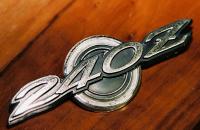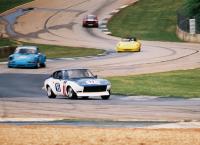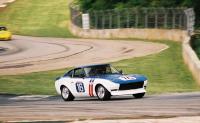Everything posted by 26th-Z
-
maybe bitter?
That's way too funny. Bitter? Hell no, she's angry!!!! Thanks seerex. That eBay made my day :love:
-
Philosophical discusion on build dates
Good morning everyone! What a great conversation. "Zeeological Carcheology" at it's best! :classic: Kats, you always send me scrambling to my boxes and bags of parts to see what I have. You challenge me. Thanks. I will post photographs of the papers for you. The original owner's manual has interesting information also. The only other dated parts I know of (now) are my wheels - date stamped 10 / 69. Alan, I am in perfect agreement with you - especially when you bring up the race car chassis scenario. Good point. The records of Ford GT-40s and Porsche 917s are littered with "spare" and "uncompleted" chassis numbers later used or completed out of production sequence. With the idea that not all cars were date stamped as US delivery cars were, lacking uniformity, we cannot simply apply a birth date. And yes, this discussion could be very similar to a Roe vs Wade debate! I don't want anyone thinking that I claim HLS30-00026 is a 1969 model year car. It is clearly a 1970 model. Evidence points to production in the fall of 1969. And now I will close with words of wisdom from my Porsche fanatic friend; "The VIN is the birth certificate and the OK sticker is the first doctor's appointment".
-
How much did you pay for your Z?
$3,500 in 1984. Daily driver in reasonable shape. She is now a garage queen and if I have less than $20,000 in the restoration, I will be surprised.
-
Philosophical discusion on build dates
The previous thread asked the question if there were any real 1969 cars and I wanted to respond here with the idea that the model year and build date are often confused. I always prefer to use the build date as the year of the car rather than an arbitrary model year date, although that could lead to some confusion. As far as I know, the Datsun 240-Z Coupe was introduced as a 1970 model year even though the construction dates go back to September 1969 for production customer sale cars. I have been meaning to get out the paperwork for my car and with this discussion I did. Down to the bank to retrieve the documentation - Her Majestys' Papers. To my surprise: Her Majesty the 26th was ordered April 3, 1970. She was delivered April 29, 1970. Her original port of entry was Jacksonville, Florida and the shipping bill lists her as HLS30U-00026 907 (green). She came standard with carpeting as listed on the window sticker. The suggested retail price including shipping and dealer prep (antifreeze) was $3632, however she sold for $3791.13 (taxes)and wasn't paid for until May 4, 1970.
-
1971 Datsun 240 Z "Factory Restored" 1 of 40
$3,600 in 1970 equals $17,000 today. The "factory" restoration cars are literally brand new. $25,000 for a brand new sports car is pretty cheap.
-
Philosophical discusion on build dates
What a great discussion and I want to thank all of you for participating. I have many questions and a couple of opinions. I bought some old seat belts to use as parts for the restoration of my originals and they are date stamped 2 / 1972. This makes no sense to me for several reasons. By 1972, the seat belts found on NA cars would have been retractor type with the later push button style buckles. All of my parts fiche information indicates such. My lovely HLS30-00026 is manufacture date stamped 11 / 69 with an engine serial number L24-2338. The seat belts are 9 / 1969. Cars with later serial numbers (such as #42) and lower engine numbers are stamped 10 / 69 and the production figures kats supplied would indicate my 26 was manufactured in October. I would say that the car becomes a car when the OK sticker is slapped on. Prior to that, it is "under construction". I would say that a "production" car is a production model intended to be sold and the rest are "test" or "study" examples. When we discuss production cars, we should exclude those cars which were not intended to be sold to the public. Finally, for lack of better information, I suggest the stamped build date be used to identify and date the car to the letter. We have no better information and it would be purely subjective to discuss a date earlier than what is stamped on the door jamb, or in the case of the AU cars, the engine bay plate. What and where were the domestic cars stamped? Is there such a chassis as HS30-00026? PS30-00026? What were the build dates for those early cars?
-
masterash bar
Oh heavens! Car magazines are filled with tours, shows and excursions of enthusiasts who take their cars to a country and "enjoy the ride". I read of BMW events, Porsche events, Ferrari events and such all the time. Yes, it is a small group that participates, but you must remember the most common place for the Z is America. This is where all the junk is. Everywhere else, the marque is an expensive collector car. Go ahead. Slap me for sounding like a snob. :classic: In the American collector car world, the 240Z is the cheapest game in town.
-
Early Z Hatch Inner Panel
Your explanation is correct, Andrew. I don't have pictures of mine, but that is how it works. Louvers in the panel, rubber flaps in a steel frame attached inside. Please ask Santa to bring me a brand new one in Butterscotch ROFL
-
masterash bar
I'm watching this conversation with great interest, you two!
-
I want a 1970 alternator
Hello kats, My engine shop manual is printed November 1969 and specifies Hitachi LT145-35, 12V - 45A. The pictures show the "grapefruit" cut away back plate. Pages EE-13 through EE-20. My alternator is packed away in a box, but I will look at it tonight and respond.
-
masterash bar
That's GREAT news, kats. I arrive Wednesday and look forward to meeting you.
-
Factory headlamp covers 240 wanted
No hijack at all, Gary. I have the brochure I picked up at the Mitty. www.lamin-x.com Clear protectant film for headlight covers as well as painted surfaces. I am seeing this stuff more and more, especially on the front of race cars because of the stone chipping problems. You almost can't see it once it is on and it comes in colors. This is a 12 mil vinyl that is applied with soapy water and a squeege. When the water film dries, the vinyl adheres like a decal and it can be peeled off. We have dreadful bugs this time of year in Florida - the kind that eat the paint - and this film is something I am considering for my car. I don't know if an MSA headlight cover kit would work in the factory frames, but if I had the problem, I sure would try it.
-
Monterey Historics --- Aug 13 - Aug 15
Another one of the "Don't Miss" events if you are in to seeing great cars. Please post pictures of the Datsuns!
-
great history site
I had an e-mail exchange with the Merlin, the site master, after cruising his site this morning. I recommend it. :classic:
-
Looking for Z Owners - Florida's Emerald Coast
Sean, We had a location poll some time ago. http://www.classiczcars.com/forums/showthread.php?s=&threadid=5916&highlight=Location I know there are owners in your area. Welcome to Florida!
-
original jute material
Thanks Andrew. I made tracings of my old jute for patterns. I have the tunnel jute pattern as well. Your photos will be valuable to me as I compare what I was able to salvage to your "pristine" examples. Has anyone found a proper replacement material? I received a sample from LeBaron Bonney and it is not the same material.
-
Social Poll...
Moved to Sarasota in 1969 from Milwaukee. One of my first new friends went to the New York Auto Show with his father who came home and immediately ordered a 240Z from the Datsun dealer - Her Majesty the 26th.
-
The Z Car's Nemesis?
I thought this discussion was about rust !?!!??! Sorry to jump in so late. I was racing SCCA in the mid '70s and the C Production class was dominated by the Z. Don Kearney was the local hero and I watched him blow off everything regularly. The Z always did best on the shorter tracks where the nimble suspension and light weight played to advantage against big powerhouse cars and Sports Racers. In later years, Sharp, Newman, and Fitzgerald kept the fire breathing with their famous drives and win records. Those cars were really tube framed chassis looking like a Z rather than the good old BRE Datsuns. The Alfa GTV ran in a different class behind Datsun 510s in B Sedan. Probably the best comparison race I ever saw was the 1971 runoffs between John Morton and Bob Tullius in a TR6.
-
Factory headlamp covers 240 wanted
I think the Datsun headlight covers are as sexy as a lace bra on a porn star and had to have a set. (headlight covers) I looked around and at one time, talked with kats about arranging a purchase from Datsun Freeway. Then, a member of this site offered to sell me a set and we have been friends ever since. We discussed the deal as though we were trading a fine bottle of wine. During that time, two sets sold on Ebay in that $500 range. I didn't get any great deal, but when you are talking about something that sexy, who cares? A guy at the Mitty had a set on his Z and they looked just great. Keep in mind that the chrome rings attach through the headlight bucket and holes are required for installation. They also fog up in the rain. At the Mitty, I talked to a retailer selling clear vinyl stone guard material to cover and protect the lens. I don't know if he had something for the complex shape, but it is a thought. The same material is used commonly to protect the front end of fiberglass on race cars. I see it frequently at vintage events. Applied properly, you really can't tell and it works. I have the stuff on my BMW headlights.
-
Glove Box Doors
You come up with some of the best questions! :classic: I will go take a look, but I think the emblem on my glove box door is on the top. I don't know if I ever saw a low emblem. Pictures?
-
'Datsun' Fender Emblems
Yes, metal fender emblems for the early cars. In fact, all metal emblems on the early cars except the hatch grills which I have only seen in plastic. "kats" has the best info site on this stuff. http://www.geocities.jp/datsunz903/ There have been discussions over the "240Z" on the hatch and the quarter panels. We commonly see the Z filled in white. Early emblems came in metal with white Zs, but the earliest Zs were chromed. The emblems are also hollow cast and kats does a great job describing the different castings. I have one (the only one I have ever seen) quarter emblem 240Z that is solid cast. The metal fender "Datsun" emblem looks the same as the plastic ones. The Datsun is filled white and the background is black. Here is the solid quarter emblem. I got into a big eBay battle over this baby.
-
Factory headlamp covers 240 wanted
Just so that you don't faint and hurt yourself I want to tell you that the last four sets I have seen sold for over $500. They look real nice, but they are expensive. This place in Japan may still have them. http://www.datsun-freeway.com/index.html
-
Walter Mitty Historic Races
I didn't get into a very long discussion with Mike nor did I dip down on the wet pavement to look at the suspension. Our conversation was limited to the time it took to start raining again! I only noticed the unmistakable gearbox bell housing casting along with other bits - front damper, distributer / electronics, oil filter and cooler. The radiator appears hand fabricated. We discussed briefly, the upper suspension pick-up points and the stabilizer bar, but the conversation turned to that famous nose piece and how the original hood must have been shortened to accomodate the fit. Then we looked at various mounting holes drilled in the front end to install it. What I do remember about the casting plates on the tops of the carburetors was the Mikuni / Solex name only. No part number or other identification. Mike said he obtained new gaskets by sending a xerox copy of the old gaskets to a fellow in Japan for replacements and thus the 44mm. With respect to the IZCC website, I suspect that the information was posted from a contributing writer as many of the other atricles are. Just wait until you see the brief I am going to write about Her Majesty the 26th when she is complete! :D
-
240Z Series 1 Tool Box Questions
I was quite surprised to find those pages in the parts book I just received. To the best of my knowledge, tools did not come standard with North American delivery cars. My quest to find them begins at once! The hold down straps for the wheel chocks and clip for the jack is particularly difficult and the ones I have seen on eBay usually come with the complete set of jack and tool bag.
-
Walter Mitty Historic Races
Hi Alan, I was hoping you could tell me some more about the Mikuni / Solex carburetors on Mike's car. I highly suspect they are competition part # 99996-E1020 which would reference 16010-E4620, the Solex 44PHH. I didn't recognize the intake manifold either. But I did see a lovely transmission 32010-E4151 or 22055 depending on which parts listing is referenced. Mike was very proud of his ride and remembered talking with you about the chassis. A quick look at the fabrication of the roll cage and rear deck indicates the shell started life as a road car. Mike was pretty convinced that his car was not "factory prepared". He seemed to think that the nose was fabricated by those who built the chassis. We briefly discussed fabricating a replica, but Mike thinks it was ugly to begin with and sees no point spending money to fabricate something that would look god-awful. Even though Mike does not know much of the Japanese side of the story, I was pleased to see it - finally after all our discussions! Steve, Try this site www.racingsportscars.com You may find the car from an old IMSA event. I have never seen it before.







